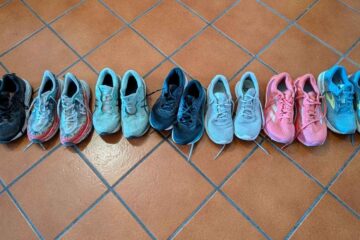I have learned the hard way for the first few races, making some mistakes along the way causing a fair amount of unneeded stress and embarrassment. That’s why I want to share the what to do’s and what not to do’s that I have personally learned for when you set up in the Transition Zone for a triathlon.
There are rules on how you must enter the transition and how to set up your equipment by your bike. Only the race participants are allowed into the Transition Zone, so don’t go asking your super spectators to come in and help set up. It’s time for you to learn the rules and know that you have set up your position perfectly for the race to commence!
Entering into the Transition
So you have your bag packed with all your transition equipment and you’ve grabbed your bike. As you enter into the Transition Zone, there will be someone checking that you are a race participant and that you have:
- Your helmet on your head and fastened up with your race number stickers placed correctly.
- Your bike with your race number sticker placed correctly.
- Your race belt number that you should put on the front of the handlebars when entering so it’s visible or make it visible if it’s attached to your running top with safety pins.
- Your timing chip attached to your ankle.
- A wrist band which is sometimes given in the pre-pack to show that you are racing and can enter the Transition Zone.
Once you are in the Tri Zone
Do a little dance that you have been accepted into the Transition and you feel the excitement starting to build. It’s getting real! But now, it’s time to focus on finding your number. The same number that you have on your helmet, bike and race belt! Look, check and check again 
One you’ve found your spot, you need to position your bike facing in the direction that the number is pointing. Rest the front part of the saddle on the bar as shown in the photo.
If you have a race belt, many triathletes rest the race belt on the handlebars of the bike. The two advantages to this are that you can easily see your number when returning from the swim, plus you can’t forget to put it on before jumping on your bike. Depending on your bike and if you have tri-bars or a race belt, you can rest your helmet across the handlebars pretty easily and pop your sunglasses (if desired) on the top too. It’s quite useful having these essentials on your bike so that you are forced to put them on and don’t accidentally leave them behind when you leave the transition zone.
The rest of your transition equipment must be placed neatly on the floor on the same side as your bike chain. Don’t go spreading your stuff everywhere, because there is a limit to how much space you can take up. You’ll also find that the bikes on either side of you are in close proximity, and therefore you must ensure that the smallest of space is taken to place your bike shoes (if you have them) and/or running trainers. If you want to wear socks, put them in your shoes and open them up ready to put your feet in. Put your nutrition on the floor, or attached to your bike frame. We always have an extra water bottle to use between transitions to sip on between each transition change, and a bright towel to help allocated the bike as quickly as possible. In the triathlon race, you may forget your race number or where you left your bike, but you might just remember the colour of your towel!
When placing your shoes and socks on the floor, open the shoes up and place the socks in a position ready for the feet to slip in nicely. During sprint triathlons, it’s common that people don’t even wear socks as that the transition times can be super fast, but don’t be tempted to try it on race day. If you haven’t run without socks before, race day is NOT the day to try out anything new.
We also love the elasticated laces for making T2 quick. Genius right? No need to tie up any shoelaces or worry that they will come undone during the run!
Phew, one less thing to worry about
- Find your place with your number
- Check your number again!
- Place your stuff on the chain side
- Keep everything compact
- Consider elasticated laces
- Stick with what you know
Orientation
This has to have a section to itself, purely because it’s something super important to do when you’re in the Transition Zone. Other than finding your number, it’s important to understand where you will be entering from and exiting from for both Transitions.
Depending on where you enter, you will find your bike in a certain way. Sometimes we count the number of rows along, but when the Zone is overwhelmingly large, we use reference points to help find our place quickly!
We even walk the route. We find where we will enter from the swim and walk the route in the Transition Zone to the bike and then from the bike to the exit. It helps stick in your head easier and avoid getting lost or losing time in the manic times during the race.
If the Transition Zone is the same for T1 (swim to bike) and T2 (bike to run), then also check out if you must enter and exit for the second transition in a different way.
Now it’s time to do another little dance, say ‘see you soon’ to your bike and go and prepare to get that wetsuit on, with your timing chip, race cap, goggles, watch and HR monitor! We’ve prepared a free Beginner Triathlon Kit List for Women which lists everything you’ll need for you triathlon race. Happy Triathlon Racing!


